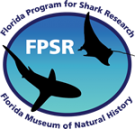Elasmobranch Nursery Areas Within the Cedar Key Region of the Gulf of Mexico
 Johanna Imhoff
Johanna Imhoff
The Cedar Key area of the Gulf of Mexico consists of several small islands situated just offshore between the Suwannee River mouth to the northwest and the Waccasassa River mouth to the southeast. This area encompasses many diverse marine habitats including sea grass beds, mangroves, mud flats, oyster bars, tidal channels, and salt marshes. The incidental capture of numerous elasmobranch species within this area off the western Florida coast by scientists working for the University of Florida and the Florida Fish and Wildlife Conservation Commission indicates this region may support a diverse and abundant assemblage of sharks and rays. This recent work suggests that bull sharks, blacktip sharks, Atlantic sharpnose sharks, bonnethead sharks, smooth butterfly rays, cownose rays, southern stingrays, bluntnose stingrays, and Atlantic stingrays all commonly occur within this region. Little is known about the life history and ecology of many of these species, particularly the ray populations. In addition, neonate and juvenile bull sharks appear to be abundant in the Waccasassa River mouth and the southern portion of Waccasassa Bay indicating this area may function as a nursery ground for bull sharks and possibly other elasmobranch species. Nursery areas are thought to enhance survivorship of neonate and juvenile sharks due to the presence of increased resources and a lack of large predators. These areas tend to be closer to land and more vulnerable to pollution and environmental disturbances making the identification and conservation of nursery habitat critical to the health of shark populations.
To investigate the nursery function of the Cedar Key area in the Gulf of Mexico, we conduct an annual monitoring study in cooperation with NMFS Southeast Fisheries Science Center. We use standardized gillnetting gear and use a random stratified sampling design to catch and tag elasmobranchs. This allows us to determine if this area functions as a nursery and Essential Fish Habitat for several elasmobranch species. The use of gear consistent with that used to study elasmobranch nursery areas in the western Gulf of Mexico and along the southern Gulf coast of Florida will allow us to compare the productivity of this area with nearby areas. To date this area of the Gulf of Mexico is largely unstudied and represents a significant gap in our knowledge of elasmobranch species within the Gulf of Mexico. In 2011 we plan to expand this study to investigate potential effects of the 2010 Deepwater Horizon oil spill and to investigate spatial and trophic resource use of multiple shark species.
The recent Deepwater Horizon oil spill will likely lead to elevated levels of polycyclic aromatic hydrocarbons (PAH) in coastal areas of the west coast of Florida. Generally, oil spills and contamination are thought to affect air breathing marine animals such as birds and seals, where animals become coated in oil often leading to fatal results. However, many fish can show cumulative sub-lethal effects of oil contamination, which are less obvious to distinguish. The effects of oil exposure can be quantified in sharks by measuring levels of PAH biomarkers in specific tissues. PAH’s are rapidly metabolized by the individual, but biomarkers of their presence are often left at elevated levels. We will monitor levels of these biomarkers in the livers and blood of two species of juvenile shark in Cedar Key, the bonnethead and Atlantic sharpnose sharks, in collaboration with Dr. Jim Gelsleichter at the University of North Florida.
The diets of juvenile bonnethead, Atlantic sharpnose and blacktip sharks have been quantified in other areas of Florida using traditional stomach content analysis, with results suggesting that similar sized shark species show high levels of dietary overlap. In addition, the long term movements of these species have also been quantified using passive telemetry, although there can be species specific differences in residence times, and spatial and temporal patterns of habitat use. However, as of yet, no studies have attempted to simultaneously quantify spatial, and trophic habitat utilization between multiple species, to determine the effects of competition on nursery function.
We will use acoustic telemetry to determine long term movement patterns and and stable isotopes to investigate trophic ecology of juvenile sharks that utilize the Cedar Key region as a nursery area. An array of underwater listening stations (VR2W) will be set up within the bay and individuals of three species (bonnethead, blacktip and sharpnose sharks) will be tagged with V16 or V13 rcode transmitters. Samples of muscle tissue will be obtained from all tagged individuals as well as additional untagged individuals. We will also obtain muscle samples from prey items, as determined by previous diet studies. Finally, samples will be obtained from primary producers in the bay, including phytoplankton, and sea grasses.
Combined, this study will provide a unique and comprehensive view of a multi-species nursery area, and the way competitive interactions structure the community. We will also try and relate differences in movements and foraging ecology between bonnetheads and sharpnose sharks to levels of PAH biomarkers in their tissues, to try and evaluate how life history and behavior may influence susceptibility to oil contaminants.